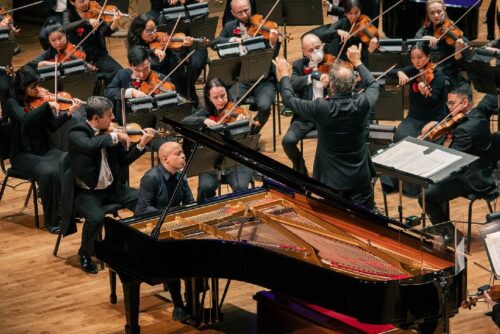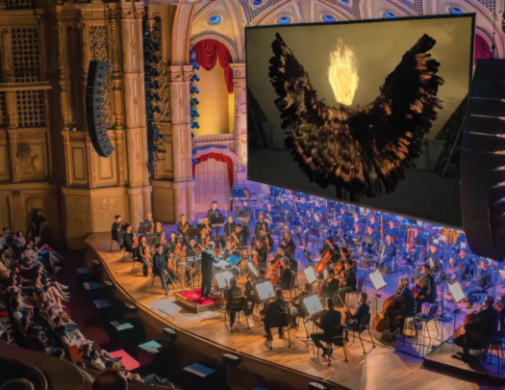 Canada Morlock, Rachmaninoff, Stravinsky: Stewart Goodyear (piano), Symphonic Cinema (director: Lucas van Woerkum), Vancouver Symphony Orchestra / Otto Tausk (conductor). Orpheum Theatre, Vancouver, 20.9.2024. (GN)
Canada Morlock, Rachmaninoff, Stravinsky: Stewart Goodyear (piano), Symphonic Cinema (director: Lucas van Woerkum), Vancouver Symphony Orchestra / Otto Tausk (conductor). Orpheum Theatre, Vancouver, 20.9.2024. (GN)

Morlock – Night, Herself (2017)
Rachmaninoff – Piano Concerto No.3 in D minor, Op.30
Stravinsky – The Firebird (complete 1910 ballet with Symphonic Cinema)
The Vancouver Symphony’s opening concert of the 2024-2025 season was about as enterprising as it gets, placing two works together that have anchored opening night festivities in recent years: Rachmaninoff’s Piano Concerto No.3 and Stravinsky’s The Firebird. The additional wrinkle was combining the latter with the North American premiere of the recently minted ‘Symphonic Cinema’. Overall, the concert was very successful, not least in wooing a younger audience to classical music and addressing post-Covid attendance concerns. Stewart Goodyear and Otto Tausk combined for a powerful performance of the concerto, while Tausk showed great improvement on his earlier attempt at the Stravinsky. The film component generally complemented these efforts, yet with qualifications. The concert began with an appropriate musical tribute to Jocelyn Morlock, the much-loved, Juno Award-winning composer and former VSO Composer-in-Residence, who sadly passed away last year.
Jocelyn Morlock’s Night, Herself is a relatively late work, written in 2017 and scored for large orchestra. It stands in contrast to the many smaller-scale compositions that have typified her output from the beginning. Perhaps in the spirit of Benjamin Britten, this piece has its roots in Purcell, and it would not be misleading to say that some of Morlock’s caprice and spontaneous imagination link her work to Britten’s.
Morlock’s ‘night’ starts serenely, with coaxing string lines and expressive woodwinds, suggestive of the English pastoral tradition. However, a stronger counterpoint and complexity take over quickly, very neoclassical in feel, suggesting that night has significantly greater activity and purpose than might be thought. It is the composer’s repeated use of a cutting trumpet chorale over the strings that often makes the proceedings slightly threatening and edgy. While there are always moments of respite and beauty, combined with the endearing little meanders that Morlock was famous for, night certainly emerges as insistent and multidimensional in its presence. The close of the work adapts a Purcellian chaconne to bring all the spirits of night together in a colourful procession that would make both Vaughan Williams and Respighi proud. Otto Tausk presented the work conscientiously, though at times I thought he might have given the work’s contrapuntal weavings more bite and shape.
Canadian pianist Stewart Goodyear brought clean, powerful pianism to the Rachmaninoff concerto and collaborated well with Maestro Tausk. Goodyear has received strong acclaim for his recent recording of the complete Beethoven sonatas, and recorded Rach 3 almost a decade ago for Steinway. He originally gained attention for his feat of performing all 32 Beethoven sonatas in a single day.
The pianist’s virtuosity in negotiating the rapid passagework of the opening movement, and his sheer energy in the bold bravura sections, were quite stunning and propelled the movement throughout its length. The pianist’s passion certainly showed itself even if the quieter, more lyrical sections seemed to breeze by rather quickly, nicely appointed as they were. Tausk established exactly the right type of repose and space at the opening of the lovely Adagio, and Goodyear entered with fine cultivation. However, as things progressed, his playing seemed to be light on expressive ardour and tenderness, only sometimes finding a telling narrative line. There needed to be more personality, more cunning, more lift of phrase. All the emotional outpouring apparently was stored for the climax of the movement. This was introduced by an unusually strong accelerando, and the result from both piano and orchestra was truly heaven-storming in its amplitude. The finale was well prepared and moved with fine integration. The ‘triumphal’ apotheosis featured all the pianistic bravura we expect and was very exciting, yet it might have been more transcendent if it were even more urgent and the quiet, musing lead-in to it was more tender.
Goodyear is an impressive pianist, and this reading turned out as an enjoyable ‘public’ performance of the concerto, bringing great strength to its obvious dramatic moments but remaining somewhat generalized elsewhere. The fact that the interpretation did not always expose the full range of emotional volatility in the music or reveal its intimacy prevented it from moving to the next level. As we have long learned, this work can fully uplift only when it lays bare the soul of the composer.
The first thing to say about Otto Tausk’s Firebird is that it was immeasurably better than his opening night attempt in his debut season. There was a clearer narrative line, more cohesion and colour, and the orchestra was better up to the work’s many challenges, from the softest tremolos through its touching lyrical episodes to its more explosive drama. The extra dimension was the projection of images onscreen. ‘Symphonic Cinema’ has received strong press in Europe and has the virtue that each conductor can set the pace of the images and scenes in line with their interpretation, rather than having to fit the music to a predetermined film score. Its originator, Dutch film director Lucas van Woerkum, was in the orchestra with his software, matching image progression with Tausk’s tempo and dynamics at cue points.
I had no problem with the coordination of images and the orchestral response. The basic idea is sort of ingenious, and the images were shot well and often thoughtful in an ‘art film’ sort of way. However, for the seasoned appreciator of this work, I am not sure how much the visual component added. It seemed to append an extra interpretative layer to the work that distracted as much as it enhanced. The combination of updated modern characters, with a ‘human’ theme of love and bonding often cast in a ‘mystery thriller’ draping, seemed almost too sophisticated for a fantastical fairy-tale where a lot of the musical expression is innocent and playful. I felt as well that the unfolding of the images was sometimes too methodical to capture the caprice, wit and sheer abruptness in the composer’s music.
Perhaps the biggest concern was that the film seemed to seek such emotional intensity and ‘larger than life’ characterization in each scene that it tended to overload the work and undercut the music’s natural ease and balance. The Firebird is a case where the music is so much better than any visual representation of its story, and I certainly was not won over by the idea that the music’s wonderfully transcendent glow at the close could be reduced to sentimental hand holding on-screen.
What is absolutely clear, however, is that these film components can offer one more resource to attract today’s young concertgoers who often expect some type of visual persuasion. The response here by the young was indeed positive. I also think that they will remember the images more than the music. Perhaps the current effort is another step towards a ‘new’ Emotionalism in music: a programme that aims to visually identify and heighten the emotions within a musical score since uninitiated listeners may find these inaccessible from the music alone. I do not particularly cherish the day when the young say, ‘Let’s get the soundtrack to The Firebird: I really enjoyed the movie’, but this does have a long history (e.g. Fantasia), and it may be a necessary step in preserving intergenerational interest in classical music.
A final concern is that the two core productions of Symphonic Cinema so far have been The Firebird and Ravel’s Daphnis and Chloe, ballets that are strongly programmatic and musically evocative and have the highest probability of selling themselves through the music alone. And if one wanted a visual input, one could actually stage the ballet! I am not sure this film representation is better than that option, although I should acknowledge that some ballet sequences did appear in this treatment. To cross the current generational divide, however, it seems we need to spawn interest in great works that are not as obviously accessible as these. For example, how might Symphonic Cinema present Schoenberg’s Variations for Orchestra?
In any case, definitely food for thought in a very successful opening concert that did indeed give us much to think about.
Geoffrey Newman
Featured Image: Otto Tausk conducts the Vancouver Symphony Orchestra in Stravinsky’s The Firebird © VSO
